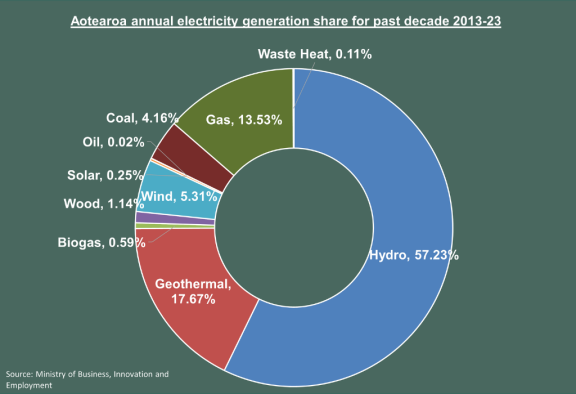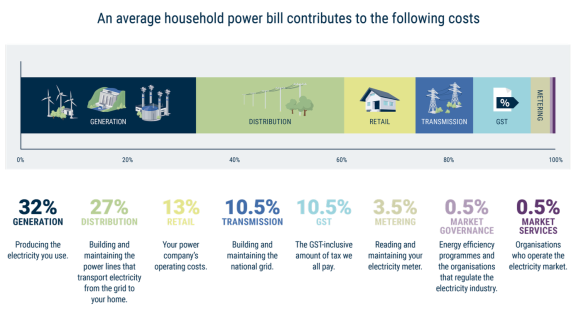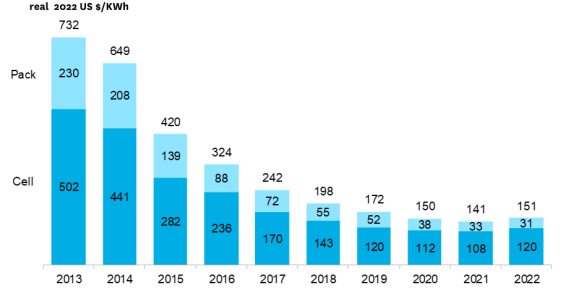Community energy sharing in Aotearoa New Zealand
Households, businesses and communities around Aotearoa New Zealand are keen to play their part in the transition to a net-zero emissions economy by 2050. Ara Ake, Kāinga Ora – Homes and Communities and Climate Connect Aotearoa are partnering to remove some of the barriers to the adoption of community energy and energy-sharing models in Aotearoa.
Aotearoa energy mix is highly renewable but more wind and solar are needed
Just over 2% of households have solar installed in Aotearoa. In Australia, almost one in three households have solar.
Aotearoa is lucky to have a high level of existing renewable electricity generation, at 82% on average each year for the past decade, according to official data (image below)
Hydropower makes up the majority of this, accounting for 57%, with contributions from geothermal at 18%, followed by wind averaging 5% for the last decade, but climbing as more wind farms are being built each year. The remainder is primarily gas and coal, with just a small contribution from solar, of less than 1%, and a little from other sources (biogas, wood, oil and waste heat). The energy system in Aotearoa has the capacity to absorb and manage a lot more solar capacity, in both grid-scale and household rooftop installations. There are significant solar projects in the pipeline waiting for resource consent or finance to move forward. The transmission grid operator, Transpower, is predicting over seven gigawatts of new solar capacity installations by the end of the decade – over 4000% of currently installed capacity.
The energy system in Aotearoa has the capacity to absorb and manage a lot more solar capacity, in both grid-scale and household rooftop installations. There are significant solar projects in the pipeline waiting for resource consent or finance to move forward. The transmission grid operator, Transpower, is predicting over seven gigawatts of new solar capacity installations by the end of the decade – over 4000% of currently installed capacity.
The electricity system of the future will look very different from today
We expect to see higher levels of variable renewables like solar, as well as new, large wind farms across Aotearoa. We also expect energy storage, including batteries and other technologies, to become more affordable.
Energy use will be optimised with ‘smart’ and controllable devices, like smart electric vehicle chargers and smart home energy management systems. Advances in data collection and analysis techniques, including machine learning, will improve energy efficiency. An affordable decarbonisation strategy will involve replacing inefficient home appliances and retrofitting underperforming housing stock.
Cyclone Gabrielle early in 2023 and the associated flooding across Aotearoa accentuated the need for resilient and adaptive solutions to climate change, such as distributed energy resources.
Community-led projects where solar panels and batteries are owned at a local level and electricity is shared peer-to-peer offer resilience to extreme weather events and act as a buffer to rising costs. In Aotearoa, there is also a strong desire amongst iwi Māori to assert rangatiratanga (self-determination) over their own energy production and use on their whenua (land).
Solar costs and generation buy-back
The upfront cost of installing panels, at an average of NZ$10,000 (according to mysolarquotes.co.nz), can be prohibitive for many households, businesses and communities, even if it does pay off in the long run. Consumers can get an idea of what it might cost using the Energy Efficiency and Conservation Authority’s solar power calculator.
Aotearoa does not provide citizens with grants or tax rebates for solar installation as is common in other countries. There are different ways to help finance solar panels:
• solarZero is the only firm in Aotearoa that offers solar and battery installations via a leasing scheme.
• Individuals and businesses may be able to add the cost of solar installation to mortgages or access relatively low-interest debt from banks.
• The Ministry of Business, Innovation and Employment (MBIE) also has a fund that provides grants for community groups, public housing providers, papakāinga and marae to set up renewable energy installations.
The average consumption tariff was 33 cents per kilowatt-hour (c/kWh) across the country in May 2023, according to MBIE’s quarterly price survey.
The solar buy-back rate for excess generation injected back into the grid varies significantly between electricity retailers. In April 2023, at least two retailers in the market were offering a solar buy-back rate as high as 17c/kWh. Other retailers offer solar buy-back rates at two-thirds or half that rate.
The website Powerswitch compares solar buy-back rates and power plans in general. The website is funded by the government to provide up-to-date and unbiased information to consumers about electricity retailers. Source: Electricity Authority
Source: Electricity Authority
Availability and storage
Energy storage helps to ensure that the costs of the overall power system do not climb as solar uptake increases. Installing a lot of solar panels, without energy storage solutions, means new power lines and large-scale generation are still needed to meet growing peak demand when the sun does not shine. This added infrastructure is a cost that is borne by everyone as a portion of their power bills. but disproportionately affects low-income Kiwis. Effectively, Kiwis without solar panels, household batteries or electric vehicles end up subsidising grid infrastructure to support the integration of these devices for Kiwis that can afford them.
Even though battery prices have fallen significantly over the last decade (shown in the diagram below), batteries remain expensive at double, or even triple, the upfront cost of committing to solar panels. This explains why most Kiwi households, businesses and communities opt for solar panels without storage, at least at first.
Volume-weighted average lithium-ion battery pack and cell price split, 2013-2022
 Source: BloombergNEF
Source: BloombergNEF
Community energy and energy sharing
Another key challenge for distributed energy solutions in Aotearoa such as solar panels and batteries, is that the benefits cannot be easily shared. Regulations currently make it difficult to share or donate excess solar generation to your neighbour. Ara Ake has made a video that helps to explain this barrier.
For example, a marae (meeting house) with rooftop solar installed cannot share excess power with the nearby kura (school) or whānau (family/community), unless all participants have signed up with the same electricity retailer and that retailer agrees to a special arrangement.). Making these special arrangements with retailers is uncommon and time-consuming, and few initiatives get off the ground.
Over the past year, Ara Ake has been working with the social housing provider Kāinga Ora in Pōneke Wellington to enable a solar-sharing trial. Kāinga Ora has been installing solar on customers’ houses in the suburbs of Porirua and Lower Hutt with a goal to reach 200 homes by February 2024, thanks to funding from MBIE’s community energy fund.
In March 2023, Ara Ake, Kāinga Ora and the pilot’s electricity sector partners jointly submitted an application to the national Electricity Authority, to allow Kāinga Ora to split excess solar generation from households’ consumption, where solar panels have been installed on public housing. Temporary regulatory exemptions were granted in June, enabling this innovative solution to be piloted. Kāinga Ora can now seek out the highest available solar buy-back rates in the market, recoup the revenues and reinvest them in further energy hardship reduction measures for its customers, particularly those that do not have the benefit of solar panels on their own homes. The trial will last for five years.
Climate Connect Aotearoa is following fast on the heels of this project, now looking to enable solar energy sharing alongside community batteries in Tāmaki Makaurau Auckland.
The aim of these pilots is to provide sufficient evidence of the benefits of energy sharing to make a case to the Electricity Authority for a permanent regulatory change so that eventually more communities will be able to set up energy-sharing projects around Aotearoa.
By advocating for changes to the underlying electricity regulations, and demonstrating the benefits of change through innovation trials, Ara Ake, Kāinga Ora and Climate Connect Aotearoa intend to unlock systems-level change that makes demand-driven climate solutions, like energy sharing, more accessible and likely to succeed across Aotearoa.
Energy Monthly
Get a different perspective on energy with our monthly newsletter.
Up next
.png)

Creating clarity during the energy transition.
Get a different perspective on energy with our monthly newsletter.

All rights reserved Energy Insights Pty Ltd




